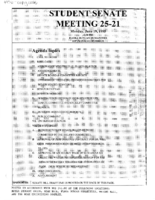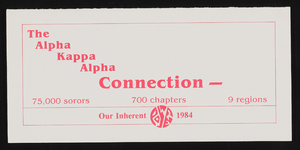Search the Special Collections and Archives Portal
Search Results
Keith Boman Papers on the Smith Center for the Performing Arts
Identifier
Abstract
The Keith Boman Papers on the Smith Center for the Performing Arts consist of materials documenting the construction of the Smith Center for the Performing Arts in Las Vegas, Nevada from approximately 2009 to 2010. The collection includes documents from the construction oversight committee, financial budgets, and board of directors meeting agendas.
Archival Collection
Sheilagh Brooks Collection on Nevada Historical Sites and Museums
Identifier
Abstract
The Sheilagh Brooks Collection on Nevada Historical Sites and Museums dates from 1977 to 1983. It contains materials including budgets, planning proposals, agenda, and minutes related to the Nevada State Museum, including proposals to build a state museum in Southern Nevada. The collection also contains National Register of Historic Places nomination forms for sites throughout Nevada.
Archival Collection
Bob McCaffery Collection on the Save the Hughes Flying Boat Campaign
Identifier
Abstract
The Bob McCaffery Collection on the Save the Hughes Flying Boat Campaign (1980-1983) documents efforts by activists to preserve the plane from destruction and its subsequent acquisition by the Aero Club of Southern California in 1980. The collection contains photographs and newspaper clippings about the Hughes H-4 Hercules flying boat nicknamed the "Spruce Goose" from the 1980s.
Archival Collection
Denny Lynch Photograph Collection
Identifier
Abstract
The Denny Lynch Photograph Collection (approximately 1900-1990) contains photographic prints and negatives of the Lynch family and their homes in Pahrump Valley and near Blue Diamond, Nevada. The photographs also depict locations and people throughout Nevada, primarily in Pahrump and Amargosa with a focus between approximately 1970 and 1990. Other photographs include local, state, and federal politicians in Nevada and Washington, D.C. Most of these photographs were collected by Denny Lynch for his newspaper, the Pahrump Tribune.
Archival Collection
Jeanne Russell Janish Photograph Collection
Identifier
Abstract
The Jeanne Russell Janish Photograph Collection (1918-1974) consists of 48 black-and-white and color photographic prints that feature Janish's family, her husband Carl Janish, family homes and pets, and travel photographs from the United States, China, and South America.
Archival Collection
Brian Gross Professional Papers
Identifier
Abstract
The Brian Gross Professional Papers (approximately 2000-2021) documents Brian Gross's career working in public relations for the adult entertainment industry. Materials in this collection includes client files, press clippings, magazines and newspapers featuring clients including Joanna Angel, Sasha Gray, and many others. The collection also contains some of marketing and financial records for BSG PR, Gross's public relations company. Also included are DVDs of adult films, BSG PR memorabilia, and some personal correspondence to Brian Gross.
Archival Collection
Dr. Charles L. Adams Graduate Studies and Department of English Records
Identifier
Abstract
The collection is comprised of Dr. Charles L. Adams' committee, senate, and association meeting minutes, correspondence, and records from 1960 to 1988 collected while he worked in both the Department of English and the Graduate Studies division of Nevada Southern University (NSU) and the University of Nevada, Las Vegas (UNLV). The collection documents the establishment of the graduate studies program at NSU before it was UNLV. The collection also includes early information about the Department of English including memoranda and course schedule planning.
Archival Collection
Nevada Division of State Parks Photograph Collection
Identifier
Abstract
The Nevada Division of State Parks Photograph Collection (approximately 1910-1940) contains black-and-white photographic prints and some corresponding negatives that depict state parks and recreational areas throughout southern Nevada. The images also portray Lake Mead, Hoover Dam, Logandale, the Valley of Fire, and Mount Charleston as well as images of actors filming on location in southern Nevada.
Archival Collection

Meeting minutes for Consolidated Student Senate University of Nevada, Las Vegas, June 19, 1995
Date
Archival Collection
Description
Text

Alpha Kappa Alpha Sorority Connection committee brochure
Date
Archival Collection
Description
From the Alpha Kappa Alpha Sorority, Incorporated, Theta Theta Omega Chapter Records (MS-01014) -- Chapter records file.
Text
